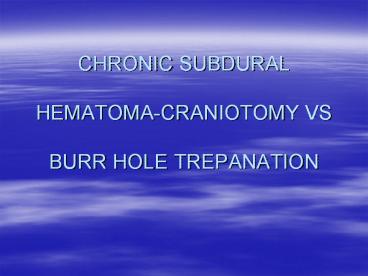CHRONIC SUBDURAL HEMATOMA-CRANIOTOMY VS BURR HOLE TREPANATION - PowerPoint PPT Presentation
1 / 30
Title:
CHRONIC SUBDURAL HEMATOMA-CRANIOTOMY VS BURR HOLE TREPANATION
Description:
CHRONIC SUBDURAL HEMATOMA-CRANIOTOMY VS BURR HOLE TREPANATION INTRODUCTION 1)chronic subdural haematoma(CSDH) is common intracranial pathology in elderly people. – PowerPoint PPT presentation
Number of Views:1347
Avg rating:3.0/5.0
Title: CHRONIC SUBDURAL HEMATOMA-CRANIOTOMY VS BURR HOLE TREPANATION
1
CHRONIC SUBDURAL HEMATOMA-CRANIOTOMY VS BURR
HOLE TREPANATION
2
INTRODUCTION
- 1)chronic subdural haematoma(CSDH) is common
intracranial pathology in elderly people. - 2)recurrence rate ranges 9.2-26.5 after surgical
interventions. - 3)incidence of CSDH likely to rise due to
increase life expectancy more number of people
receiving anticoagulant ,antiplatelet agents.
3
(No Transcript)
4
- Craniocerebral injuries from acute subdural
haematoma subdural hygroma results in formation
of chronic subdural haematoma.
5
MECHANISM
- Neomembrane produced by dural border cells in
unresolved hygroma results in vascularization
with fragile blood vessels and repeated
bleedings. - Failure of resorption of coagulated blood with
subsequent granulation tissue and angiogenesis
with fragile blood vessels in setting of ASDH.
6
TREAT MENT OPTIONS
- 1)Burr hole craniotomy
- 2)trepanation twist drill craniotomy with or
without irrigation/with or without drainage.
7
- Ususal presentation of chronic subdural
haematoma - 1)Headache
- 2)Decrease conciousness
- 3)Aphasia
- 4)Behavioral disturbances
- 5)Paresis
- 6)Seizure
8
- During 5 yrs study at neurosurgery department at
Hannover (between march 2003-july 2008) - Pre and post operative CT images taken.
- Pre-operative clinical appearance post
operative clinical outcome.
9
RISK FACTORS
- Anticoagulant therapy
- Antiplatelet agents
- Coagulopathy
- Alcohol abuse
10
- Out of 193 patients
- 151 patients had osteoplastic craniotomy with
subdural drainage and low suction vacuum
reservior. - 42 patients had burr hole trepanation with
subdural drainage and low suction vacuum
reservior.
11
- Careful irrigation with ringer lactate followed
in every operation untill the irrigation solution
remained clear. - All the drains were removed within 3 days.
12
(No Transcript)
13
- Patients mean age 72.5 yrs
- Males113(59)
- Females80(41)
- Chronic subdural hematoma location
- 90 cases(47) in left hemisphere.
- 74 cases(38)in right hemisphere.
- 29 cases(15)in both hemisphere.
14
- 40patients were receiving antiplatelet and
anticoagulant therapy. - Coagulopathy obsereved in 2 patients.
- Alcohol abuse present in 6 of patients.
15
- Most frequent clinical signs were
- Hemiparesis112(58)
- Decrease conciousness70(36.3)
- Aphasia46(23.8)
- All the patients with above clinical signs showed
chronic subdural hematoma in CThead.
16
Post-operative clinical improvement
- CRANIOTOMY GROUP
- Complete clinical recovery 68.9(104)
- No change in clinical condtion or worsening
31.1(47)
- BURR HOLE GROUP
- Complete clinical recovery85.7(36)
- No change in clinical condtion or worsening
14.3(06)
17
- Recurrence rate was 27.8(42 cases) in patients
treated with craniotomy drainage - And 14.3(06 cases) in patients treated with burr
hole drainage. - Seizures were observed in 15 patients (6.7)
pre-operatively in 14 patients (7.3)
post-operatively.
18
- 137 patients(70)or their relatives documented
history of head trauma. - Mean interval for development of CSDH is 37.3
days(range 1-230 days.)
19
RECOVERY AND DISCHARGE INDICES
- 79 cases(52.3)with craniotomy and sub dural
drainage - 27 cases(64.3)with burr hole and sub dural
drainage were discharged home for self care.
20
- 16 cases(8.6)discharged to another specialist
department for treatment of accompyning disease. - 8 cases(5.3) in craniotomy group and
- 3 cases(7.2) in burr hole group were sent to
nursing home. - 7 cases(4.6)of craniotomy group and
- 1 case(2.4) of burr hole group died in
hospital stay because of internal disease not
directly attributable to CSDH.
21
(No Transcript)
22
- Incidence of pre-op seizures was 6.7
- Post-op seizures incidence7.3
- Chen-et-al correlated increase incidence of
post-op seizures in patient with left unilateral
CSDH and CT appearance of mixed density type
lesion.
23
(No Transcript)
24
- Santarious-et-al randomised 215 patients with
CSDH with drain and without drain. - Use of drain with burr hole irrigation is
associated with lower recurrence rate,,better
neurological status at discharge and lower
mortality at 6 months.
25
- Zakaria-et-al compared 42 patients treated with
burr hole craniotomy(with drainage) without
irrigation and 40 patientswith irrigation and
drainage. - No significant difference in outcome between both
groups was observed. - A recurrence rate was same (12.2)
26
- Okado-et-al compared 20 patients treated by burr
hole irrigation with 20 patients treated by burr
hole drianage. - Hospitalization (post-op)stay was 14.1 in
drainage group. - Hospitalization (post-op) stay was 25.5 in
irrigation group.
27
CONCLUSION
- Single institution 5 yrs retrospective study of
193 patients was done with consideration of
clinical presentation,surgical technique and
outcome of CSDH. - History of trauma recognised in 71 with mean
interval of time gap of 37 days.
28
- Antiplatelet and anticoagulant therapy was
present in 40 of patients. - Most frequent pre-operative symptom was
hemiparesis(58) - 75 of patient had surgery succesfully performed.
29
- 25 received revision surgery with 3
cases(1.6)undergoing craniectomy as second
revision. - CSDH is a common disease very frequent in elderly
population predominantly affecting male patients. - Burr hole trepanation evacuation seems to lead to
superior results.
30
- Osteoclastic craniectomy might represent surgical
option in complicated recurrent cases.

